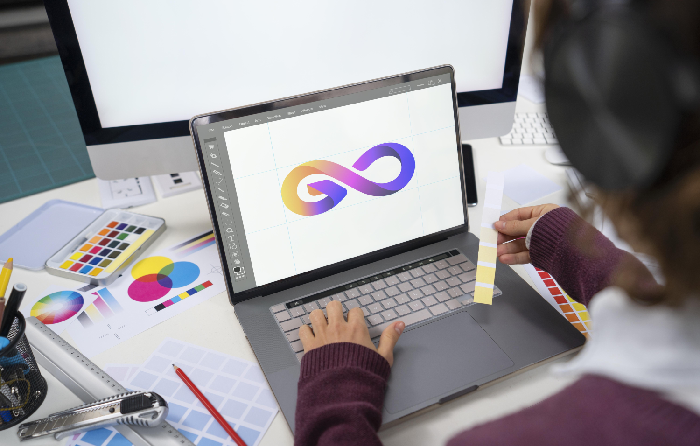6 Tips for Creating an Outstanding Brand Emblem

A logo is much more than a catchy design; it represents the soul of your brand. Your logo visually symbolizes your brand and should communicate the essence, goal, and identity of your company.
6 Tips :
- Maintain Simplicity
- Crafting Lasting Memories
- Embracing the Fundamentals of Design Theory
- Create a Logo Suitable for Multi-Platform Use
- Crafting Content with Your Target in Focus
- Select Tools Aligned with Your Purpose
1. Maintain Simplicity
Keep things basic when it comes to logo design. Clean and uncomplicated logos are easier for your audience to recognize and provide a quick sense of who you are. Keep your logo as simple as possible to allow your brand’s individuality to show through.
Because your logo will be used across several platforms, the finer characteristics of an overcomplicated design will soon fade across multiple sizes and formats. Take a step back and remove any unneeded design components to create a strong, timeless logo with a few core aspects that are immediately identifiable and effectively represent your message.
2. Crafting Lasting Memories
Your logo needs to convey the correct message and make a big impression. It’s important to make your logo distinctive and memorable if you want people to recognize your brand right away. Consider the impression and memory that you want your audience to have of your brand at first glance.
“It’s crucial to make sure the design of a logo accurately represents the business and is memorable and unique.”It can be a good idea to start by taking inspiration from existing designs or from nature itself.
Use basic design elements to create a logo that is memorable (such as fun shapes, mascots, or customized typography). Try something different. In this overly branded world, logos that play it safe risk being overlooked or discounted, even though following trends in logo design can be inspiring and a great way to stay current.
Look for logos in your industry to get ideas for unique logos, and try to steer clear of any trends or patterns you come across. For instance, electronics and globes are common in tech logos, and smiles and teeth abound in dentistry. Even though each of these motifs expresses the businesses’ mission statement quite well, they often blend into one another. Dare to stand out from the crowd!
3. Embracing the Fundamentals of Design Theory
Every outstanding logo is supported by a framework that adds visual interest, balance, and design integrity. By incorporating design principles like scale, symmetry, balance, and proportion into your logo design process, you’ll not only create a more polished and eye-catching final product, but you’ll also gain a better understanding of design conventions and when to defy them.
Scale, color, and typography are crucial considerations because they have an impact on the final result.
When creating a logo, there are numerous design principles to take into account, including balance, unity, contrast, emphasis, and repetition, to mention a few. You don’t have to use every one of these components in your design; instead, choose the ones that will best serve the brand you are creating for and improve the way your message is conveyed.
4. Create a Logo Suitable for Multi-Platform Use
Everywhere your brand is visible, including on your website, business cards, product packaging, and social media accounts, will feature your logo. Your logo must therefore continue to be true to itself and fulfill the same function on all platforms and channels. Making sure a logo functions in every scenario is crucial when designing one. Visible contrast is one way to accomplish this, but you can also use other branding components, like textures or patterns, to enhance your logo across different versions.
It is imperative to ensure that the logo functions properly across a range of sizes and media. When viewed on screen or printed, a well-designed logo should have noticeable contrast and clarity. To ensure that the brand colors are accurate across all media and that the brand is consistent, the logo should be exported in the correct format that is appropriate for printing (CMYK) and viewing on screens (RGB).
5. Crafting Content with Your Target in Focus
Both your audience and your brand should be reflected in your logo. Your logo design should be appealing to your target market and include components that are consistent with your company, products, brand, and audience’s interests.
It’s important to think about how the target audience might interpret the logo. “If this step is skipped, the company might draw the wrong kind of customers, which could hurt sales.”
You can choose a specific look, style, or personality for your logo based on what you want to convey by having a thorough understanding of the needs of your target audience and how they view your brand. If you’re not sure, ask your customers or yourself what makes your brand unique from those of your rivals.
Authenticity, attention to detail, creativity, sustainability, efficiency, or something else entirely could be this competitive advantage; showcase it in your logo.
6. Select Tools Aligned with Your Purpose
It might be difficult to create a logo for your company, and it can be hard to know where to start. Thankfully, you have access to some excellent tools to assist you. Regardless of your level of experience or financial limitations, it is critical to select the appropriate tool for your needs, objectives, and company requirements.
One way to develop a unique logo is with Adobe Illustrator, which is vector-based, or Adobe Photoshop, which is raster-based, provided you have the necessary design skills. Both applications offer robust, flexible logo-creation solutions with an extensive toolkit. Photoshop is better for more deformed, grunge, and edgy-looking logos, whereas Illustrator works well for modern, flat logos.
Place it is another well-liked choice; it’s an online platform for graphic design and logo creation.
